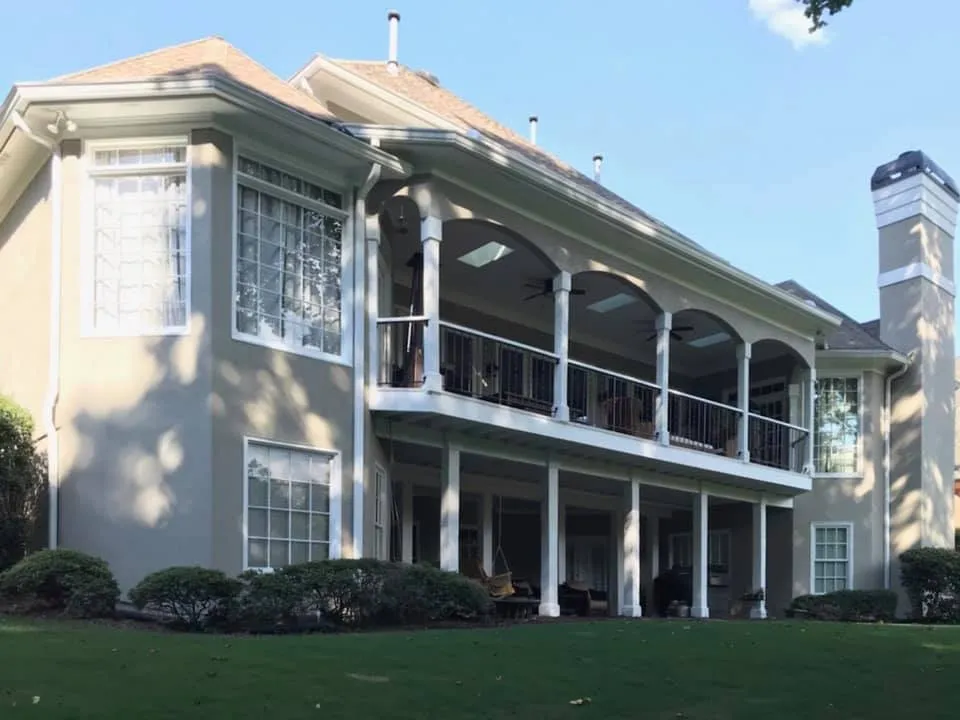Stucco Finish
Experience the durability and aesthetic appeal of plaster coating, an ideal solution for commercial structures, with our Advanced Stucco Repair ensuring your building’s exterior remains in prime condition.
Have a question before scheduling?
Expert Stucco Installation & Repair for Homes and Businesses in Georgia
Experience predictable project costs with transparent pricing – materials, labor, and cleanup included. Proudly serving Georgia for over 24 years.
- Clear, upfront pricing with no hidden fees or surprises
- Prompt, local service—flexible scheduling for both homeowners and builders.
- Expert stucco installation and repair for commercial and residential properties.
- Clean, professional work zones with respect for your property and timeline.
- Easy estimates and communication with a responsive local team.
- Quality craftsmanship that meets local codes and enhances long-term value.

Our Stucco Process: What to Expect From Start to Finish
Request Your Quote
Tell us about your project – residential or commercial – and we’ll provide a detailed, no-obligation estimate with clear timelines.
On-Site Evaluation
We inspect the property to assess existing surfaces, moisture control, and project scope to ensure accurate pricing and flawless results.
Material Selection & Preparation
We help you choose the right stucco type, texture, and color for your building, then prep the surface for proper adhesion and durability.
Expert Application
Our licensed team applies each layer with precision — from scratch coat to finish coat — ensuring consistency, strength, and visual appeal.
Curing & Quality Inspection
After application, we allow proper curing time and perform a full quality check to confirm color uniformity, adhesion, and finish integrity.
Cleanup & Final Walkthrough
We leave the site clean and conduct a final walkthrough with you to guarantee satisfaction before closing out the project.
Exploring the Versatility of Stucco Finishes
Stucco finishes offer a unique blend of durability and aesthetics, enhancing the exterior appeal of commercial structures. From smooth stucco finish to sand stucco finish, we provide a variety of options tailored to your needs. Ready to transform your building’s facade? Contact us today.
- Our acrylic stucco finish provides a weather-resistant layer, ensuring long-lasting protection.
- Choose from different stucco finishes like lace stucco finish or santa barbara stucco finish for a distinctive look.
- We use high-quality materials like quikrete stucco finish coat for superior results.
- Our expert team can guide you through the process, helping you select the ideal exterior stucco finishes for your structure.


Optimizing Your Building’s Facade with Stucco Finish
Whether you’re in the hospitality, retail, or corporate sector, the exterior of your building plays a crucial role in making a lasting impression. However, factors like budget constraints and regulatory compliance can make choosing the right approach challenging. Advanced Stucco Repair helps navigate these complexities, guiding you towards the perfect stucco finish – be it a smooth stucco finish for a sleek look or a sand stucco finish for added texture.
- We provide comprehensive consultations to help you understand different stucco finishes and select the one that best suits your project requirements and budget.
- Our team leverages its expertise to ensure your chosen stucco finish, whether it’s an acrylic stucco finish or a lace stucco finish, adheres to all industry regulations and standards.
- We offer maintenance advice post-installation to extend the lifespan of your exterior stucco finishes, ensuring they continue to enhance your building’s appeal.
- With our assistance, even complex projects involving special materials like quikrete stucco finish coat become manageable and stress-free.
Amplifying Your Structure’s Appeal with Stucco Finishes
Stucco finishes not only elevate the aesthetic appeal of your building but also provide practical benefits. These finishes are known for their robustness, offering a sturdy exterior that withstands various weather conditions. Moreover, they require minimal maintenance, saving you time and resources in the long run.
- The versatility of stucco finishes types allows you to customize your building’s exterior according to your preferences, be it a stucco dash finish for a rustic look or an acrylic finish stucco for a glossy appeal.
- Stucco finishes like the santa barbara stucco finish and smooth stucco finish offer an excellent balance between style and durability, ensuring your structure stands out without compromising on longevity.
- Our team is proficient in applying different stucco finishes, ensuring a seamless application process that results in an impressive and lasting facade.
- With options like the quikrete stucco finish coat, we ensure high-quality results that enhance your building’s curb appeal while providing reliable protection against external elements.

Take the Next Step with Advanced Stucco Repair
Ready to enhance your building’s exterior with a unique stucco finish? Contact us today for a tailored consultation and quote on our range of high-quality stucco finishes.
Our dedicated team at Advanced Stucco Repair is at-the-ready to provide you with great customer service and first class Stucco Finish. Reach out to us at (888) 592-1304 to discuss your Stucco Finish needs today!

Diving Deeper into Stucco Finish Techniques
At Advanced Stucco Repair, we employ a meticulous application process for stucco finishes. We start with a thorough surface preparation, followed by the application of a base coat. The chosen stucco finish, be it a sand finish stucco or an acrylic stucco finish, is then applied in a uniform manner to ensure even coverage and optimal durability. Our team’s expertise ensures precision in every step, from selecting the right kind of stucco finish to its flawless application.
- Surface preparation is key to ensuring the longevity of the stucco finish. This includes cleaning and priming the surface for optimal adhesion.
- We apply the base coat with care to create a solid foundation for the final stucco finish coat.
- The choice of stucco finishes types is crucial as each offers unique aesthetic and functional benefits. We guide you in this selection process.
- Our team applies the chosen exterior finish stucco meticulously for an even and durable result.
- We follow industry best practices throughout our workflow to ensure superior results and customer satisfaction.
Investing in Stucco Finish: A Cost Perspective
The cost of a stucco finish can vary based on several factors. These include the scope of the project, site accessibility, labor requirements, equipment used, and compliance with industry standards. Additionally, market conditions and seasonality can influence pricing. Remember that quotes for services like applying a santa barbara stucco finish or an acrylic stucco finish will depend on the specifics of your building and project.
- The size and complexity of your project directly influence the cost due to variations in labor and material requirements.
- Accessibility to the site can affect equipment needs and labor hours, impacting the overall price.
- Compliance with industry standards may necessitate specific materials or techniques, influencing cost.
- Seasonality can affect availability of labor and materials, potentially affecting pricing.
- The type of stucco finish chosen, such as a lace stucco finish or a quikrete stucco finish coat, can also impact cost due to differences in material prices.


Commercial Applications of Versatile Stucco Finishes
Stucco Finish finds widespread use in commercial settings, offering a blend of aesthetic appeal and durability. For instance, a retail store might opt for a lace stucco finish to create a distinctive exterior, while a corporate office might prefer the sleek look of an acrylic stucco finish. Similarly, hospitality establishments often choose finishes like the santa barbara stucco finish to exude an inviting ambiance.
- Retail outlets can enhance storefront appeal with unique finishes.
- Corporate buildings may use sleek finishes for modern aesthetics.
- Hospitality establishments often prefer inviting stucco textures.
- Public facilities can benefit from the durability of stucco finishes.
Implementing Stucco Finish: Our Methodical Approach
At Advanced Stucco Repair, our process for applying stucco finishes is systematic and thorough. We begin with an in-depth site evaluation to understand your building’s specific needs. Based on this assessment, we develop a custom plan that includes selecting the right type of stucco finish, scheduling the work, and ensuring safety and compliance at every step. Whether you prefer a santa barbara stucco finish or a smooth stucco finish, our process ensures optimal results.
- We conduct a comprehensive site evaluation to assess your building’s exterior and identify the best stucco finish options.
- Our team develops a customized plan that outlines the scope of work, including the selection of materials like quikrete stucco finish coat if required.
- We schedule the work in consultation with you to minimize disruption to your operations.
- Safety measures are implemented throughout the project to protect both our team and your property.
- We ensure compliance with industry standards during every phase of the project for quality assurance.

Testimonials From Our Customers
At Advanced Stucco Repair, we believe that every exterior matters. Home and business owners trust us for expert stucco installation, repairs, and maintenance—whether it’s a single-family residence or a commercial building. We focus on dependable service, clear communication, and results that last.

Frequently Asked Questions about Stucco Finishes
Here are some common queries we receive about our stucco finish services, covering practical aspects like scope, timelines, and safety measures.
What factors determine the scope of a stucco finish project?
The scope of a stucco finish project is determined by several factors including the size of your building, the chosen type of stucco finish such as smooth or sand finish stucco, and the current condition of your building’s exterior.
How long does it take to apply a stucco finish?
The timeline for applying a stucco finish varies based on the project’s complexity. For instance, applying an acrylic stucco finish may require additional time due to its unique application process compared to other types of finishes.
What kind of access is needed for a stucco finish project?
We require clear access to all exterior walls of your building. Any obstructions like outdoor furniture or landscaping features may need to be temporarily moved to ensure seamless application of the chosen stucco finish.
What safety measures are taken during the application process?
We adhere strictly to industry safety standards throughout the application process. This includes using appropriate protective equipment and ensuring that all work areas are secure and hazard-free during the application of any type of stucco finishes.
How is scheduling and communication handled during a project?
We work closely with you to schedule work times that cause minimal disruption. Regular updates are provided throughout the project, keeping you informed about progress and any changes in timelines or scope.
